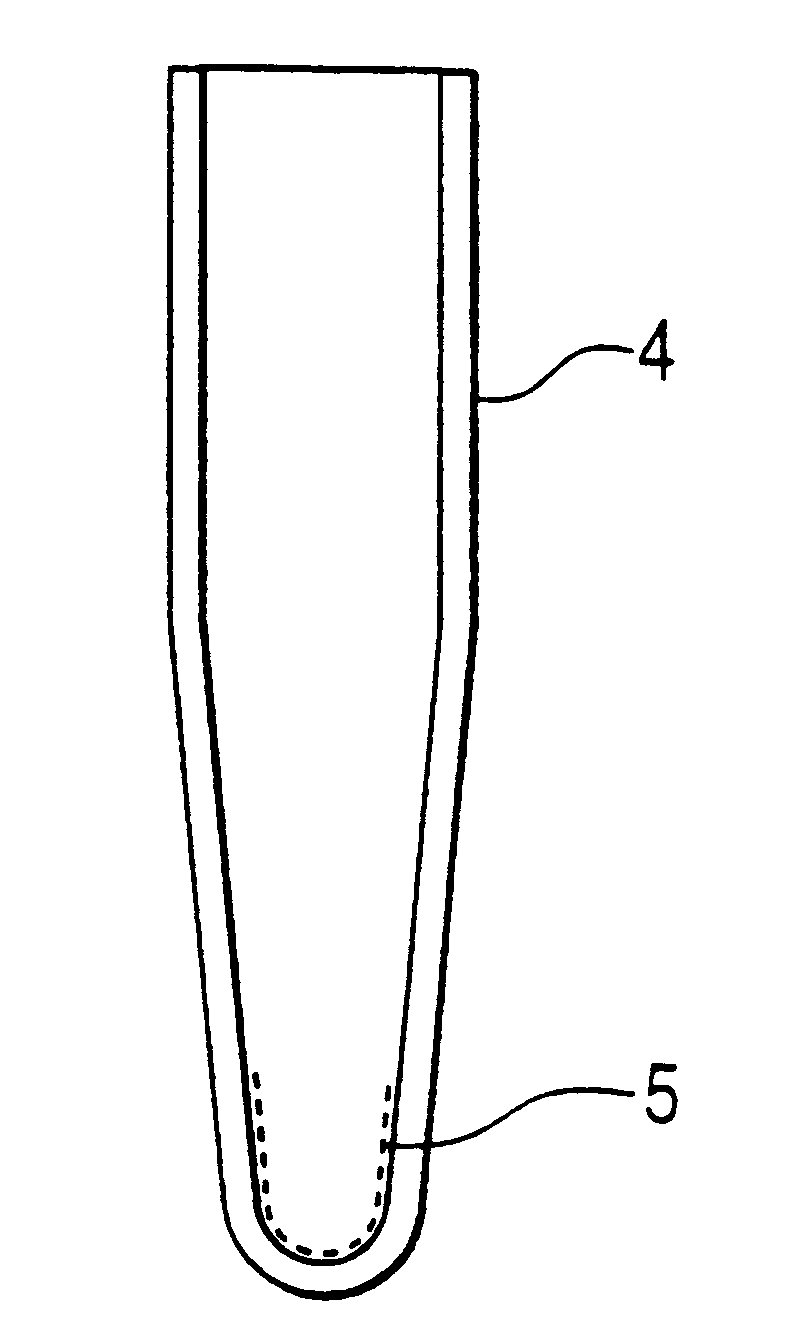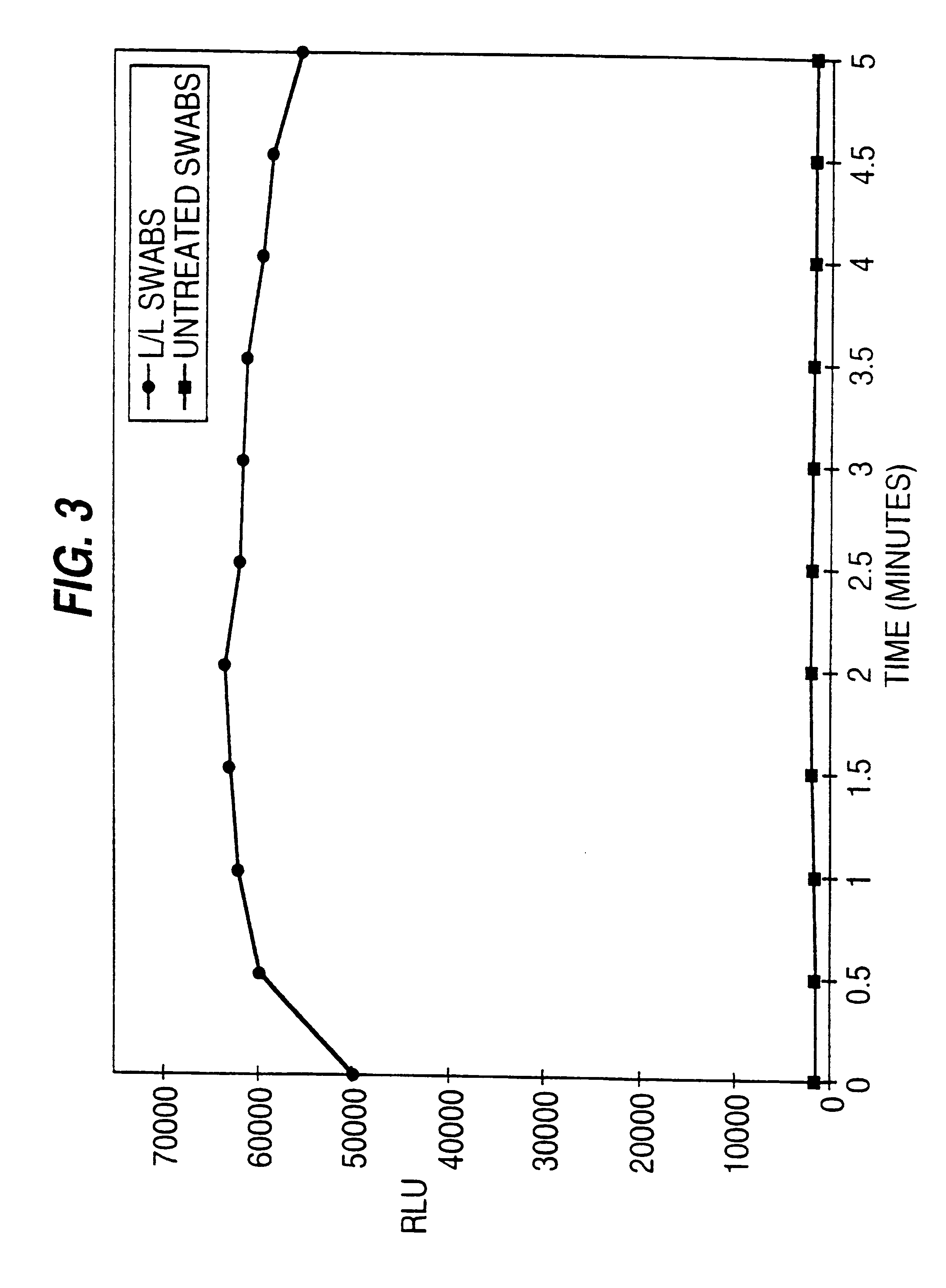Method and apparatus for rapid hygiene testing
a technology of rapid hygienic testing and apparatus, applied in the direction of biochemistry apparatus, biochemistry apparatus and processes, microbiology, etc., can solve the problems of inaccurate bacterial cultures, insufficient amount of atp, and insufficient simple cleaning or sanitizing of surfaces
- Summary
- Abstract
- Description
- Claims
- Application Information
AI Technical Summary
Benefits of technology
Problems solved by technology
Method used
Image
Examples
example 1
20 .mu.l of a bacterial culture was placed on a sterilized surface. Next, two drops of extractant chlorhexadine diacetate (CDA) were added. Then, a luciferase / luciferin-treated swab was rubbed on the test surface and the extractant was absorbed. In addition, a control swab that contained no luciferase / luciferin reagent was tested under identical conditions. Each swab was placed in a counting tube and inserted into a luminometer where the amount of light produced was measured for five seconds at 30 second intervals for five minutes. The results are shown in FIG. 3. Each point represents the mean of three repeated tests. The results demonstrate the efficacy of the invention for detecting the ATP present in a bacterial sample. ATP was measurable with the luciferase / luciferin treated swab, but not the control untreated swab. The amount of light produced by the reaction is relatively stable over the five minute period.
example 2
Two types of samples were tested for the presence of ATP. The first sample was a bacterial culture. The second sample was an ATP solution. Four 20 .mu.l aliquots of each sample were placed on a sterile surface. Next, two drops of CDA extraction reagent were added to each of the aliquots and then the aliquots were allowed to sit for a period of time, depending on the sample; one aliquot of each sample was allowed to sit for 0 minutes, another for 1 minute, another for 5 minutes, and a final for 10 minutes. Next, after the designated amount of time, a luciferase / luciferin reagent-containing swab was rubbed on the surface of the sample and the extraction reagent was absorbed into the swab. Next, the swab was placed in a counting tube which was then inserted into a luminometer to measure any light produced. Each experiment was repeated three times and the mean of the results were plotted. The results are shown in FIG. 4 and demonstrate that the amount of ATP present remains stable in th...
example 3
Two experiments were performed with the same bacterial sample and CDA extraction reagent as Example 1. The first experiment was performed with a solution of the luciferase / luciferin reagent used to prepare swabs. The second experiment was performed using a luciferase / luciferin treated swab.
In the first experiment, four separate 125 .mu.l aliquots of the extractant were mixed with 50 .mu.l aliquots of the luciferase / luciferin solution in luminometer counting tubes. Each of the four mixtures was then allowed to sit for a period of time. The first sat for 0 minutes; the second sat for 1 minute; the third sat for 5 minutes; and the fourth sat for 10 minutes. After the designated period of time, 20 .mu.l of bacterial culture was added to the tube. The tube was then placed in a luminometer and the amount of light produced was measured. Results for the first experiment are depicted in FIG. 5 by the "Solution" curve and illustrate the originally expected but undesirable result that mixing o...
PUM
| Property | Measurement | Unit |
|---|---|---|
| diameter | aaaaa | aaaaa |
| pH | aaaaa | aaaaa |
| height | aaaaa | aaaaa |
Abstract
Description
Claims
Application Information
 Login to View More
Login to View More - R&D
- Intellectual Property
- Life Sciences
- Materials
- Tech Scout
- Unparalleled Data Quality
- Higher Quality Content
- 60% Fewer Hallucinations
Browse by: Latest US Patents, China's latest patents, Technical Efficacy Thesaurus, Application Domain, Technology Topic, Popular Technical Reports.
© 2025 PatSnap. All rights reserved.Legal|Privacy policy|Modern Slavery Act Transparency Statement|Sitemap|About US| Contact US: help@patsnap.com



